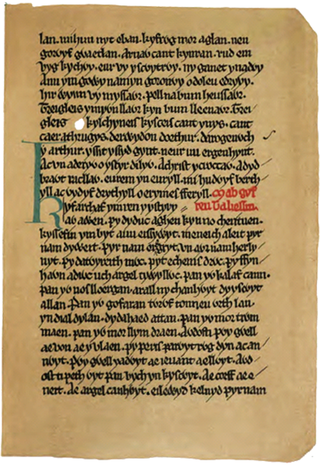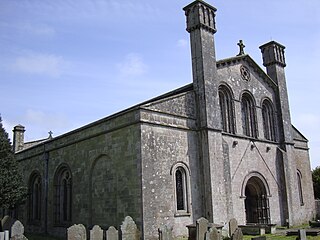Aneirin, also rendered as Aneurin or Neirin and Aneurin Gwawdrydd, was an early Medieval Brythonic war poet who lived during the 6th century. He is believed to have been a bard or court poet in one of the Cumbric kingdoms of the Hen Ogledd, probably that of Gododdin at Edinburgh, in modern Scotland. From the 17th century, he was usually known as Aneurin.

The Red Book of Hergest, Oxford, Jesus College, MS 111, is a large vellum manuscript written shortly after 1382, which ranks as one of the most important medieval manuscripts written in the Welsh language. It preserves a collection of Welsh prose and poetry, notably the tales of the Mabinogion and Gogynfeirdd poetry. The manuscript derives its name from the colour of its leather binding and from its association with Hergest Court between the late 15th and early 17th century.

The National Library of Wales, in Aberystwyth, is the national legal deposit library of Wales and is one of the Welsh Government sponsored bodies. It is the biggest library in Wales, holding over 6.5 million books and periodicals, and the largest collections of archives, portraits, maps, and photographic images in Wales. The Library is also home to the national collection of Welsh manuscripts, the National Screen and Sound Archive of Wales, and the most comprehensive collection of paintings and topographical prints in Wales. As the primary research library and archive in Wales and one of the largest research libraries in the United Kingdom, the National Library is a member of Research Libraries UK (RLUK) and the Consortium of European Research Libraries (CERL).

The Welsh Triads are a group of related texts in medieval manuscripts which preserve fragments of Welsh folklore, mythology and traditional history in groups of three. The triad is a rhetorical form whereby objects are grouped together in threes, with a heading indicating the point of likeness; for example, "Three things not easily restrained, the flow of a torrent, the flight of an arrow, and the tongue of a fool."

The White Book of Rhydderch is one of the most notable and celebrated surviving manuscripts in Welsh. Mostly written in southwest Wales in the middle of the 14th century it is the earliest collection of Welsh prose texts, though it also contains some examples of early Welsh poetry. It is now part of the collection of the National Library of Wales, having been preserved in the library at Hengwrt, near Dolgellau, Gwynedd, of the 17th century antiquary Robert Vaughan, who inherited it from the calligrapher John Jones and passed it to his descendants. The collection later passed to the newly established National Library of Wales as the Peniarth or Hengwrt-Peniarth Manuscripts.

The Black Book of Carmarthen is thought to be the earliest surviving manuscript written solely in Welsh. The book dates from the mid-13th century; its name comes from its association with the Priory of St. John the Evangelist and Teulyddog at Carmarthen, and is referred to as black due to the colour of its binding. It is currently part of the collection of the National Library of Wales, where it is catalogued as NLW Peniarth MS 1.

The Book of Taliesin is one of the most famous of Middle Welsh manuscripts, dating from the first half of the 14th century though many of the fifty-six poems it preserves are taken to originate in the 10th century or before.

Peredur son of Efrawg is one of the Three Welsh Romances associated with the Mabinogion. It tells a story roughly analogous to Chrétien de Troyes' unfinished romance Perceval, the Story of the Grail, but it contains many striking differences from that work, most notably the absence of the French poem's central object, the grail.

"His Shadow" is a poem in the form of a cywydd by the 14th-century bard Dafydd ap Gwilym, widely considered the greatest of the Welsh poets. It relates a conversation in which the poet defends his character from the insinuations of his own shadow, and it parodies a popular medieval genre in which the Soul remonstrates with the Body. It has been argued that "His Shadow" was written towards the end of Daydd's poetic career. It was accepted in the 2007 edition of Dafydd ap Gwilym's poems by Dafydd Johnston et al. as a genuine work of his; previously, Thomas Parry had included it in his 1952 edition of Dafydd's works and in his Oxford Book of Welsh Verse (1962) as genuine, though in 1985 he expressed some doubts as to Dafydd's authorship.
Brenhinoedd y Saeson is the medieval title of a Middle Welsh annalistic chronicle. The name means 'the kings of the English'.

Brut y Brenhinedd is a collection of variant Middle Welsh versions of Geoffrey of Monmouth's Latin Historia Regum Britanniae. About 60 versions survive, with the earliest dating to the mid-13th century. Adaptations of Geoffrey's Historia were extremely popular throughout Western Europe during the Middle Ages, but the Brut proved especially influential in medieval Wales, where it was largely regarded as an accurate account of the early history of the Celtic Britons.
Ieuan ap Rhydderch ab Ieuan Llwyd was a Welsh bard.

The White Book of Hergest was an important Welsh manuscript compiled in c. 1450. It contained many Welsh poems and prose texts and was a significant source for several antiquaries of the 17th and 18th centuries, but disappeared in the early 19th century, probably being destroyed in a fire in a London bookbinder's shop in around 1810.
The Black Book of Chirk is a 13th-century Welsh-language manuscript, known also as the Chirk Codex. It is Peniarth 29 of the National Library of Wales, and deals with legal and historical matters. It contains also an elegy addressed at Llywelyn ap Iorwerth; king of Wales. This poem was probably written by his grandson Llywelyn ap Gruffudd who lived in the 13th century.

The Peniarth Manuscripts, also known as the Hengwrt–Peniarth Manuscripts, are a collection of medieval Welsh manuscripts now held by the National Library of Wales in Aberystwyth. The collection was originally assembled by Robert Vaughan of Hengwrt, Merionethshire. During the 19th century it was held in Peniarth Mansion, Llanegryn.
Daniel Huws FLSW is the world's leading authority of the last hundred years on Welsh manuscripts, with contributions that are held to represent a significant advance on those of John Gwenogvryn Evans.
Thomas Wiliems was a Welsh-language antiquarian.

"The Magpie's Advice" or "The Magpie's Counsel" is a poem in the form of a cywydd by the pre-eminent Welsh-language poet, Dafydd ap Gwilym. The poet portrays himself as an overage lover who bemoans his romantic woes as he wanders through the woods, and is rebuked by a magpie who bids him concern himself with matters more befitting his years. It can be read either as a comic and self-mocking reversal of the traditional Welsh poetic trope of the non-human messenger, or llatai, being sent to the poet's lover, or as a meditation on the contrast between the yearly cycle of renewal in the natural world and the linear ageing of men, which falsifies any simplistic identification we may make with nature. It has always been one of Dafydd's more popular poems, surviving in 55 manuscripts and being widely translated in the 20th and 21st centuries. Sir Thomas Parry included it in his Oxford Book of Welsh Verse.












